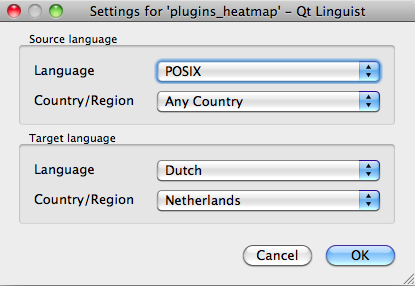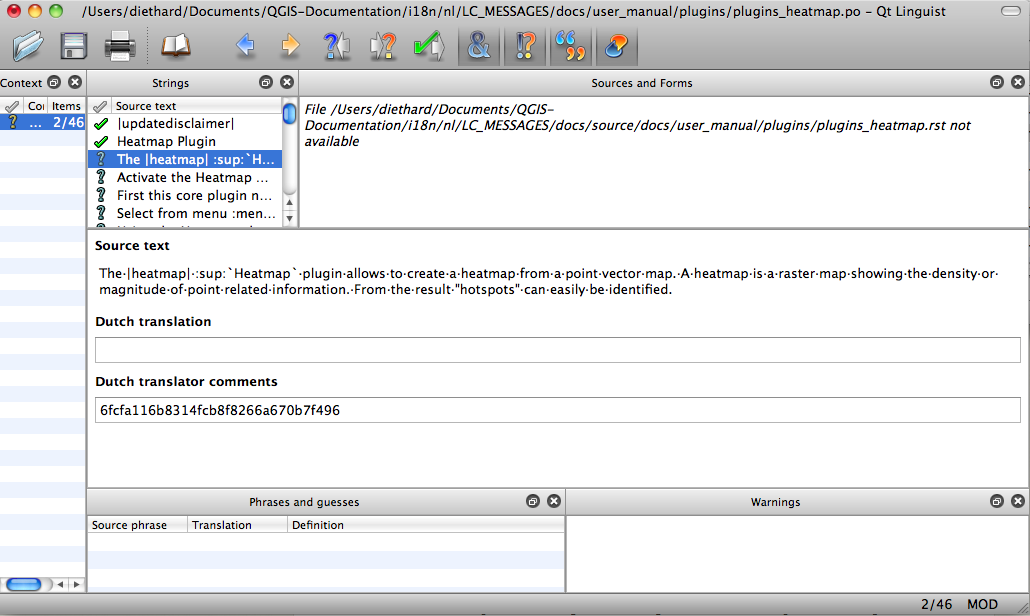Ghidul traducerilor¶
This manual is aiming to help the translator. First the general process of how technically a translation is done is explained. Later the translation is explained from an actual English rst document that is translated to Dutch. Finally a summary of “Rules of translation” is given.
Foreword¶
A first important note: If you want to translate content within the docs folder (not web), never do this in the master branch. For translations there are always translation branches available, once a document is fully updated in english for a certain version. As an example the branch to translate the manual of QGIS 1.8, you have to use the manual_en_v1.8 branch. For questions, please contact the qgis-community-team at http://lists.osgeo.org/mailman/listinfo/qgis-community-team.
General information¶
Pentru a explica cum funcționează traducerea, vom folosi plugin-ul Heatmap ca exemplu. În acest exemplu, îl vom traduce din engleză în olandeză, dar procedeul va fi, practic, similar pentru traducerea în oricare altă limbă.
First translation¶
To create documentation first rst documents are created. A prebuild script creates translation files named .po files for the english language in the folder /QGIS-Documentation/i18n/en.
Aceste “originale” sunt copiate de către script în folderele i18n pentru celelalte limbi.
The sentences in the .po files needs to be translated from english to the language with a translation tool editor. There is a web translation tool called pootle we would like to use, but it is not activated yet. However there is an excellent tool supplied with the qt development tools named Qt Linguist.
When you want to contribute, first get a .po file and add translations for the sentences in the .po file.
When you are finished the .po file is placed back in the right place and during the next build the buildscript now creates .mo files next to the .po files.
These .mo files are actually used by the script to create translated output.
Update translations¶
When afterwards an rst document is updated a new .po file is created in the english part. The contents of this new file will be merged with already existing .po files for each language. This means that when a new line is added to an rst document that was allready translated, only the new/updated sentences are added in the translated .po file and needs to be translated. The amount of work for updating translations for next versions of QGIS should be relative small.
Translate a .po-file¶
For this example we will use the relative smaller rst document for the heatmap plugin. The source of the document can be found here:
QGIS-Documentation/source/docs/user_manual/plugins/plugins_heatmap.rst
Deci, de ce am ales acest document?
Este considerat terminat, pentru versiunea curentă. În cazul în care încă nu este finalizat, următoarea declarație, urmată de o linie vidă, pot fi observate în partea de sus a documentului.
|updatedisclamer|Aceasta va produce o declinare de responsabilitate, vizibilă în produsul rezultat. Este mult mai bine ca traducerea unui document să înceapă cu o astfel de informare, deoarece există șanse mari ca ulterior să fie necesară o corecție.
Aceasta va include, de asemenea, imagini, legende, antete, referințe și înlocuiri.
Eu l-am scris, deci este mult mai ușor pentru mine să efectuez traducerea ;-)
The build process has created the English .po file which can be found here:
QGIS-Documentation/i18n/en/LC_MESSAGES/docs/user_manual/plugins/plugins_heatmap.po
The equivalent Dutch .po file (basically a copy) can be found here:
QGIS-Documentation/i18n/nl/LC_MESSAGES/docs/user_manual/plugins/plugins_heatmap.po
Along this file you will see a tiny .mo file which indicates that it does not hold any translations yet.
Now I will grab this .po file and start translating it. During this translation session I will point out which parts (rst statements) need translation.
Traducere în Qt Linguist¶
When you open the .po file in Qt Linguist for the first time you will see the following dialog:
Figure Translation 1:
Limba Țintă trebuie să fie completată corect. Limba Sursă poate fi lăsată așa cum este, cu limba POSIX și Țara/Regiunea pe Orice Țară.
When you press the [OK] button Qt Linguist is filled with sentences and you can start translating, see Figure translation 2.
Figure Translation 2:
În meniu veți vedea următoarele butoane, ușor de utilizat.
The Translation Done Next button, is the most important button. If the item needs translation, you enter a translation in the text field, then hit this button. If the item does not translation just leave the text field for translation empty and also hit this button which indicates the item is done and you continue with the next item.
Butonul Goto Previous, poate fi folosit pentru a merge la elementul tradus anterior.
Butonul Goto Next, poate fi folosit pentru a merge la următorul element de tradus.
Butonul Next Todo, efectuează saltul la prima traducere care necesită o traducere. Este foarte util atunci când documentul original s-a schimbat și numai câteva expresii noi/modificate trebuie să fie traduse.
Butonul Previous Todo, caută înapoi și sare la primul element de traducere care necesită o traducere.
Traduceți un manual¶
Acum vom începe traducerea manualului pentru pluginul_heatmap!
The first two items do not need translation, just push the toolbar button which considers the translation finished and jump to the next item.
When I get to the third item we see a more interesting sentence to translate:
The |heatmap| :sup:`Heatmap` plugin allows to create a heatmap from a point vector map. A heatmap is a raster map showing the density or magnitude of point related information. From the result "hotspots" can easily be identified.
- Această frază conține două declarații rst:
|heatmap|cuvintele dintre|sunt înlocuiri și nu ar trebui să fie traduse niciodată! Acesta, de exemplu, va fi înlocuit de pictograma plugin-ului Heatmap!:sup:`Heatmap` `` the ``:sup:statement is a superposition statement and prints the following text a bit higher. This is used to show the popup texts that appear when you hover above the toolbar item and this may be different when it is actually translated in the QGIS application. In this case it is not!
Toate celelalte texte simple din această propoziție pot fi traduse!
The fifth translation item contains the :ref: rst statement that is
commonly used to refer to another section somewhere in het manual! The text
following a :ref: statement should never be changed because it is a unique
identifier!
First this core plugin needs to be activated using the Plugin Manager (see Section :ref:`load_core_plugin`). After activation the heatmap icon |heatmap| can be found in the Raster Toolbar.
In this case “load_core_plugin” is a unique reference identifier placed before an rst item that has a caption. The ref statement will be replaced with the text of the header and turned into a hyerlink. When the header this reference is refering to is translated, all references to this header will be automatically translated as well.
Articolul următor conține eticheta rst :menuselection: urmat de textul afișat, în mod curent, într-un meniu din aplicația QGIS, acesta putând fi tradus în cerere și, prin urmare, ar trebui să fie schimbat atunci când este cazul.
Select from menu :menuselection:`View -->` :menuselection:`Toolbars -->` :menuselection:`Raster` to activate the Raster Toolbar when it is not yet activated.
La punctul de mai sus “View –>”este, de fapt, tradus ca “Beeld –>”, aceasta fiind traducerea olandeză utilizată din aplicația QGIS.
Un pic mai departe vom întâlni următoarele elemente greu de tradus:
The |heatmap| :sup:`Heatmap` toolbutton starts the Dialog of the Heatmap plugin (see figure_heatmap_2_).
It holds a reference to a figure figure_heatmap_2_, and like a reference
to section this reference should not be changed!! The reference definition
itself from the rst-document is not included in the .po file and can therefore
not be changed. This means the reference to figures can not be translated. When
HTML is created you will see figure_heatmap_2. When a PDF document is
created figure_heatmap_2_ is replaced with a figure number.
Următorul element de traducere cu atribute rst este următorul:
**Input Point dialog**: Provides a selection of loaded point vector maps.
Do not remove the stars in above line. It will print the text it holds in bold. The text itself is often text included in the dialog itself and may wel be translated in the application.
Următoarea traducere conține eticheta rst :guilabel:.
When the |checkbox| :guilabel:`Advanced` checkbox is checked it will give acces to additional advanced options.
The text Advanced of the guilabel tag may wel be translated in the QGIS application and probably needs to be changed!
The following translation item contains ``airports``. The apostrophs are used this to give text another textfont. In this case it is a literal value and does not need translation.
For the following example, we will use the ``airports`` vector point layer from the QGIS sample dataset (see :ref:`label_sampledata`). Another exellent QGIS tutorial on making heatmaps can be found on `http://qgis.spatialthoughts.com <http://qgis.spatialthoughts.com/2012/07/tutorial-making-heatmaps-using-qgis-and.html>`_.
This item also includes a hyperlink with a url and an external presentation. The url should ofcourse be left intact, you are allowed to change the external text “http://qgis.spatialthoughts.com” which is visible by the reader. Never remove the underscore at the end of the hyperlink which forms an essential part of it!!
Sumarul regulior pentru traducere¶
- Do not change replacements like
|nix| - Do not change references that start with the tag
:ref: - Do not change references that end with an underscore like
figure_1_ - Do not change the url in hyperlinks, but you may change the external description. Leave the underscore at the end of the hyperlink
- Change the contents of
:sup:,:guilabel:and:menuselection:, Check if/how it is translated in the QGIS Application. - Text between Double Stars and double apostrophes often indicate values or fieldnames, sometimes they need translation sometimes not.
- Be aware to use exactly the same apostrophes of the source text.
- Don’t end the translated strings with a new paragraph, otherwise the text will not be translated during the html generation.
Respectați regulile de mai sus iar documentul tradus va arăta foarte bine!


